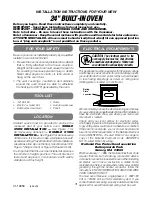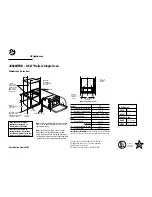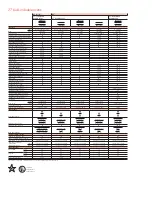
en
Tested for you in our cooking studio
48
Meat thermometer
You can cook accurately using a meat thermometer.
Read important notes on using the meat thermometer in
the corresponding chapter. There, you can find notes
on inserting the meat thermometer, the possible heating
types and additional information.
~
"Meat
thermometer" on page 24
Recommended setting values
You can find the ideal heating type for many meat
dishes in the table. Temperature and cooking time
depend on the amount, composition and temperature of
the food. Settings ranges are indicated for this reason.
Try using the lower values at first. You can increase the
temperature next time if necessary.
The setting values apply to chilled meat placed into the
cold cooking compartment. By doing so, you can make
energy savings of up to 20 per cent. If you preheat the
oven, you can reduce the indicated cooking times by
several minutes.
You can find information on roasts and default values
for weights in the table. If you wish to roast a heavy joint
of meat, you should definitely use a lower temperature.
If roasting several joints, use the weight of the heaviest
piece as a basis for determining the cooking time. The
individual pieces should be approximately equal in size.
As a general rule: the larger a roasting joint is, the lower
the cooking temperature and the longer the cooking
time.
Turn roasting joints and grilled items after approx.
^
to
Z
of the indicated time.
If you wish to follow one of your own recipes, you
should use similar dishes as a reference. You can find
additional information in the tips on roasting, braising
and grilling attached to the settings table.
Remove unused accessories from the cooking
compartment. This will achieve the best possible
cooking results and energy savings of up to 20 per
cent.
Types of heating used:
■
:
4D hot air
■
%
Top/bottom heating
■
4
Circulated air grilling
■
(
Grill, large area
The levels of steam intensity are indicated as numbers
in the table:
■
1 = Low
■
2 = Medium
■
3 = High
Dish
Accessories/cookware
Shelf posi-
tion
Type of
heating
Tempera-
ture in °C
Grill
setting
Steam in-
tensity
Cooking
time in
mins.
Pork
Joint of pork without rind, e.g. neck,
1.5 kg
Cookware, uncovered
2
4
180-190
-
-
110-130
Joint of pork without rind, e.g. neck,
1.5 kg
Cookware, uncovered
2
:
180-190
-
1
130-150
Joint of pork with rind,
e.g. shoulder, 2 kg
Wire rack
2
4
190-200
-
-
130-140
Joint of pork with rind,
e.g. shoulder, 2 kg
Cookware, uncovered
2
:
120
-
3
25-30
4
190-200
-
-
25-30
:
170-180
-
1
70-80
Pork tenderloin steak, 1.5 kg
Cookware, uncovered
2
4
220-230
-
-
70-80
Pork tenderloin steak, 1.5 kg
Cookware, uncovered
2
:
170-180
-
1
80-90
Pork fillet, 400 g
Wire rack
3
4
220-230
-
-
20-25
Pork fillet, 400 g
Cookware, uncovered
3
4
210-220*
-
1
25-30
Smoked pork on the bone, 1 kg
(with a little added water)
Cookware, covered
2
4
210-230
-
-
70-90
Smoked pork on the bone, 1 kg
Cookware, uncovered
2
:
160-170
-
1
70-80
Pork steaks, 2 cm thick
Wire rack
5
(
-
2
-
16-20
Pork medallions, 3 cm thick
Wire rack
5
(
-
3*
-
8-12
Beef
Fillet of beef, medium, 1 kg
Wire rack
2
4
210-220
-
-
40-50
Fillet of beef, medium, 1 kg
Cookware, uncovered
2
:
190-200
-
1
50-60
* Preheat
** At the start, pour approx. 200 ml of liquid into the cookware; the water tank must be topped up during operation
*** Slide the universal pan in underneath at shelf position 2
















































